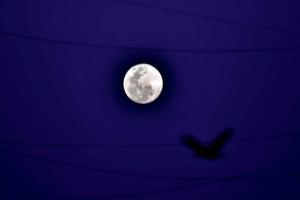This rare phenomenon will occur on October 31, marking the Wiccan Sabbat Samhain, more commonly known as Halloween

A blue moon is the third Full Moon in a season of four Full Moons. File pic/Pradeep Dhivar
The year 2020 will see the occurrence of a rare phenomenon — the blue moon— on October 31. This is the first time that a blue moon will occur since it last appeared twice in the year 2018, on January 31 and March 31.
ADVERTISEMENT
Although the phrase "once in a blue moon" is commonly used to describe a rare occurrence, the term, in its technical sense, is used to indicate a second Full Moon that occurs within a calendar month. In other words, the particular calendar year in question will have 13 Full Moons instead of the normal 12 (one full moon per month).

Arvind Paranjpye, director of the Nehru Planetarium
According to Arvind Paranjpye, director of the Nehru Planetarium, a blue moon is defined as "the third Full Moon in a season of four Full Moons." Speaking to mid-day, he said, "The earliest reference to this definition is found in the Maine Farmer's Almanac, published annually as a reference book for farmers in the late 1930s. It carried useful information for farmers, such as weather forecasts, planting charts, etc."
This year's blue moon holds significance because of the date it falls on—October 31—which marks the Wiccan Sabbat Samhain, more commonly known as 'Halloween' in the West, as well as the festival of Kojagiri Purnima (or Sharad Purnima) that is celebrated annually in the Indian calendar. The latter will precede the blue moon by a day. According to Paranjpye, the festival of Kojagiri Purnima traditionally takes place in the Indian calendar after the monsoon season expires and before the winter season sets in properly. "This is a time for celebration and merrymaking…that takes place when the skies are clear, with a full moon. The festival also marks the period when the Sun travels to the southern (or Dakshinayan) part of the sky, making nights longer than days," he said.
What causes a blue moon
"There are 12.3681 lunar months in one solar year. That means a normal solar year has 12 full lunar months, with an extra 0.3681 months (or 10 days, 20.9 hours extra). This extra time accumulates over the months. After about 30 months there will be one extra Full Moon in the year. This implies that one of the four seasons will have four Full Moons instead of the normal three Full Moons. And when this happens, the third Full Moon of that season is simply called a 'Blue Moon'," said Paranjpye.
This year October has two Full Moons, with the first one on October 2 at 02:35 IST, and the second on October 31 at 20:19 IST. This second Full Moon will be the blue moon. The next blue moon will occur on August 31, 2023.
Keep scrolling to read more news
Catch up on all the latest Mumbai news, crime news, current affairs, and a complete guide from food to things to do and events across Mumbai. Also download the new mid-day Android and iOS apps to get latest updates.
Mid-Day is now on Telegram. Click here to join our channel (@middayinfomedialtd) and stay updated with the latest news
 Subscribe today by clicking the link and stay updated with the latest news!" Click here!
Subscribe today by clicking the link and stay updated with the latest news!" Click here!






